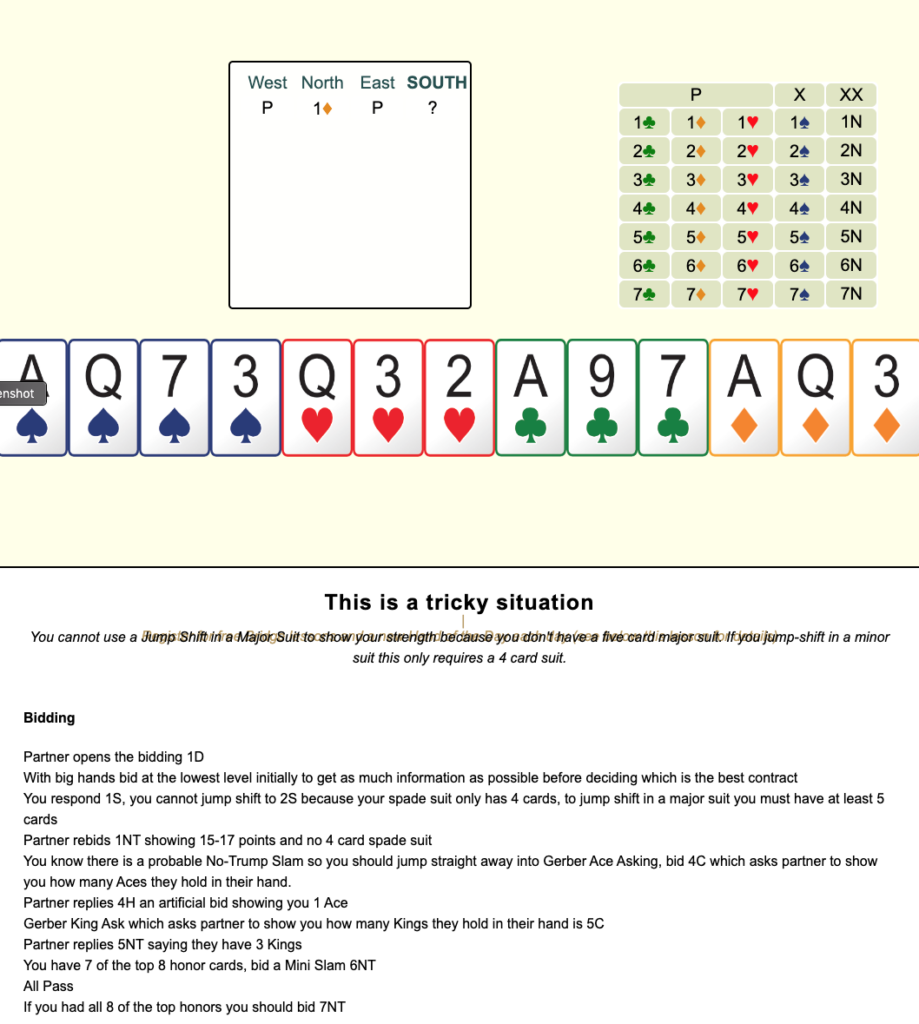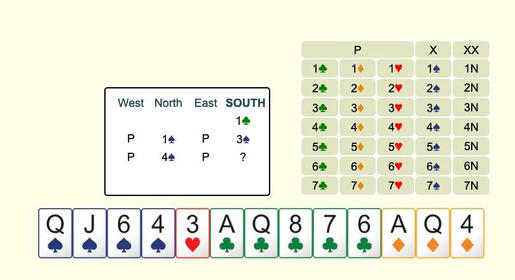HOME > BRIDGE LESSONS > ACOL BRIDGE LESSONS
Jump Shift Responder Bids
A jump-shift response always shows partner a long suit and a strong responding hand, without guaranteeing a high-card point count.
With a strong hand 17+ points
Description
A jump-shift is where the bidder bids one level higher than they needed to. Meaning they could have bid at a lower level in the same suit, but they didn’t. Jump shifts can be made by either the opener or the responder but the points required are different for each position. This lesson is concerned with responder jump shifts. If the responder has 13+ points they are able to make a jump shift bid.
YOU ARE VIEWING A SHORT EXTRACT OF OUR BRIDGE LESSON
The full version of our lessons, in our Premium Members area, are interactive and include inline glossaries, quizzes and multiple practice hands to play on each topic. Subscribe to our Premium Members area (try it free for 30 days) to get access to over 400 hours of interactive Bridge lessons and Bridge learning activities.
REVIEWS FROM OUR PREMIUM MEMBERS AREA
“the daily challenge is awesome” – Daniel, Massachusetts, USA
“I love everything. The lessons are nicely sequential and easy to follow.” – Nancy, Virginia USA
“I absolutely love this website. I spend hours everyday on it. Helps enormously.” – Lesley, California
“your site gives me confidence.” – Brigid, Ireland
FULL REVIEWS

CAN YOU SOLVE THIS HAND?
This is a Tricky Situation
You cannot use a Jump Shift in a Major Suit to show your strength because you don’t have a five card major suit. If you jump-shift in a minor suit this only requires a 4 card suit.
PLAY THE SOLUTION (no login required)
When to jump-shift
1. A jump-shift response can be most useful for those hands where you want to invite a slam, not insist on one.
2. A strong jump-shift should be made only when you have a one-suited hand with good honor strength in your suit, slam-try strength or better and a good rebid.
3. A jump-shift response is most useful when you want to describe your hand to partner in terms of points and shape.
A jump-shift describes the following types of hands
- A strong hand (17+ pts.) with one long, strong suit holding at least two of the top three honors.
- An intermediate hand (13-16 pts.) with a long, solid suit and good controls.
- A balanced slam-invitation (17 to a “bad” 19 pts.) with a good 5-card suit.
If you found this lesson useful, you will find the extra features in our members-only lessons especially valuable. The above video demonstrates how our lessons appears in our members area. The ‘members only’ version of our lessons includes popup glossaries for Bridge terms, an instant quiz to test your new Bridge knowledge, and multiple practice hands with full commentary. Access our members area with a full featured free trial.
When not to jump-shift
Even with very powerful hands, you should make a low-level response any time you need general information from partner about his strength and distribution. Avoid making a jump-shift with the following types of hands:
A jump-shift doesn’t always promise a distributional hand – it can also be made with a good 5-card suit and balanced strength. With very strong hands, there may be a problem finding a good rebid after your jump-shift, so in that situation try to keep the auction at a low level rather than jump shift responding.
- Holding a two- or three-suited hand.
- With one-suited hand with a bad suit (missing two or more top honors).
- When you have a suit that needs good honor support or length from partner.
- A very strong, balanced hand.

INSTANT BRIDGE LESSON – Can you revalue your hand after finding a ‘Fit?’
Once you and your partner have found an 8 card fit there are extra points available if you have voids, singletons or doubletons, this usually makes your hand even stronger.
Play this hand: Play with Standard American Bidding | Play With Acol Bidding